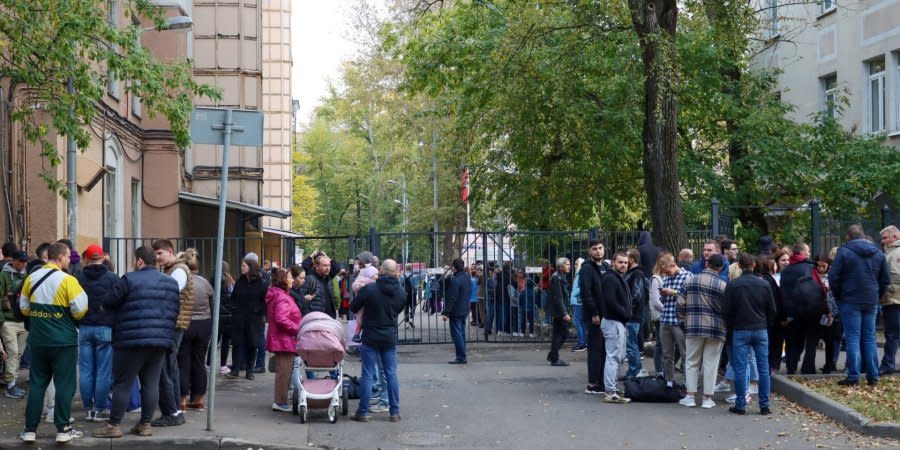Putin plans to mobilize a lot more than 300,000 troops, analyst says

- Oops!Something went wrong.Please try again later.
In an interview with NV Radio, Conflict Intelligence Team analyst Kyrylo Mykhailov talks about how the mobilization effort is going so far, and how it will change the war in the months to come.
NV: Mobilization in Russia has been underway for three days now. What can we say about how it’s going thus far?
Mykhailov: We can already conclude that it won’t follow the most threatening scenario – an orderly call-up, with several training stages, equipment training, and combat cohesion drills.
Read also: Videos show Russians sent to war in Ukraine under Russian mobilization
From the reports we’re getting, these mobilized troops can expect two weeks’ worth of training, at best. Many of these men never served in the army and have no combat experience whatsoever. Naturally, it’s impossible to properly train them on such short notice.
Furthermore, some sources claim that up to 1-1.2 million people are going to get mobilized, meaning that Russian army logistics won’t be able to cope. We see people being dumped at training centers that are clearly not ready, with men left to sleep on the ground. It’s likely there won’t be enough instructors to train them, either – most of these officers have already been deployed to Ukraine earlier in the war.
NV: What would Russian supply lines look like if they manage to deploy these 300,000 to occupied Ukrainian territories?
Mykhailov: Russia’s initial invasion force was below 200,000 troops, in terms of active combat units. Even 300,000 mobilized men would be double of that. If the reports about 1 million troops are true, any existing logistics chains will simply crumble.
Read also: Russia disproportionally targets ethnic minorities with mobilization notices
Russia was already struggling to supply its existing force in Ukraine. More than doubling it means they won’t have even the bare necessities to fight effectively.
Theoretically, we could assume this force would be enough to hold against Ukrainian counter-offensives a prevent another crushing Russian defeat – like that Kharkiv operation was – at least in the short term.
Long-term, Ukraine still holds the advantage, by way of having experienced, veteran troops, soaring morale, and a high degree of social mobilization.
Additionally, Kyiv has at its disposal very modern intelligence sources – both domestic and provided by NATO countries, on top of cooperative, patriotic population of Russia-occupied territories.
Finally, Western equipment continues to flow to Ukraine, even if we’re not getting everything we’re asking for. At any rate, this hardware is miles ahead of whatever Moscow can hope to outfit its fresh troops with.
Due to all these factors, most experts agree that Ukraine’s advantage is trending upwards, Russian mobilization notwithstanding.
NV: Russian armed forces number 900,000 people, in addition to two million-strong reserve. Why is Putin conscripting students and Buryats from the streets, instead of waging the war with what he already has?
Mykhailov: Regions like Buryatia and Dagestan has disproportionately more military bases – that’s the formal explanation for mobilization hitting these regions particularly hard.
Read also: Mobilization won’t solve the many problems of the Russian army, says Pentagon
Some suggest it’s a part of an effort expend ethnic minorities in these poor areas. Most likely, the mobilization quotas are based on how many military personnel live there.
Russian military commissars have a very poor understanding of exactly how many reservists there are in any given region. Their military mobilization infrastructure was essentially decimated in the late 2000s, never to be rebuilt.
Read also: Seven key takeaway’s from Putin’s “partial mobilization”
With no preparation or organization, this hasty call-up is very chaotic.
Several publicly available documents suggest these 300,000 men are supposed to begin their training on Sept. 26, even if it’s just the first wave. That’s a huge amount of people to muster in just several days, meaning they have no other option than to grab anyone they can get a hold of, hoping to fulfill the quotas, however misguided they may be.
NV: How would comment on the reports that Putin actually ordered the mobilization of a million men?
Mykhailov: That’s possible. The first “training” wave begins on Sept. 26. Judging by the scale of the ongoing mobilization, it will include 300,000 people.
At least two sources suggested Putin ordered three of even four waves, each taking two weeks, stretching into early November. If each of them involves 300,000 troops, the one-million figure sounds plausible.
NV: Could this new force be used to invade Ukraine from the north?
Mykhailov: Theoretically, if they manage to get a million troops, yes. But recall how much grief the Russian had with their logistics back in March, when they were dashing for Kyiv from Belarus.
Read also: Russian police detain hundreds of people at anti-mobilization protests
With a force several times larger this time around, they would face much greater logistical challenges. The Russian army is notoriously slow to react and adapt, so it will take them a very long time to overcome those challenges. They would have to pull all their trucks from storage, only to realize they had either been sold off or scrapped for parts. The next step would be to try and marshal civilian trucks – something no one has ever trained or planned for. All this would be exacerbated if they choose to advance from the north, as their supply routes have been switched to the south and east in recent months, at least to some degree.
Read the original article on The New Voice of Ukraine

